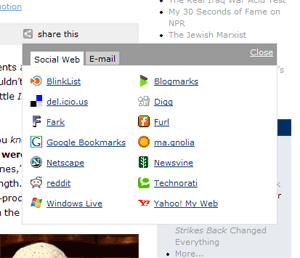[Quick reminder before we get underway: my Jewish Marxist Werewolves in Bolivia Infoquake giveaway contest is still open! Deadline is this Friday, and lots of opportunity for you — yes, you — to win a signed copy of the book.]
I’ve nearly completed all the modifications I wanted to make on this blog for 2007. Finally this weekend I cleared one of the last remaining hurdles: a good hook to social bookmarking and Web 2.0 sites.
I found that hook with Alex King’s Share This plug-in for WordPress.

Look at the gray bar underneath the headline of any article on this site. Along with “permanent link,” “comments,” and “trackback,” there’s now a “share this” link. Click it and give it a whirl. (If you’re viewing this article on LiveJournal, MySpace, or SFNovelists, you can look at the screen shot to the right instead. Or view this article on my WordPress blog.)
The Share This plug-in is a godsend, because it eliminates the bane of so many blogs and websites these days: the growing clutter of Web 2.0 link buttons. We’ve all seen them. They’ve spread throughout the footers and sidebars of the World Wide Web like kudzu. Alex’s plug-in takes the whole kit-n-caboodle and tucks it nicely in a dynamic pop-up. Look, ma, no mess!
The list is fairly easy to configure if you’re comfortable editing a well-commented PHP document. You can use the list of other social web-type services found on 3spots’ list of blog footer buttons. Obviously I don’t have accounts with all these services, so all y’all blog readers will have to let me know if there’s a button that’s misbehaving. And let me know if there are any services I’m missing.
So far, the plug-in seems to be working extraordinarily well, and I can only hope it will allow my blog to continue to grow and dominate the blogosphere. Perhaps next year, I’ll look back at all the rival bloggers I’ve mercilessly slain on the field of Technorati and have Alex King to thank for it. (Hopefully Mr. King will even forgive me for grayscaling his nice standardized share icon.)
Of course, there’s always room for improvement, so I’m going to throw in my two cents about things I’d add or change in the plug-in.
- A user-configurable e-mail comment. If you’re sending the article to someone via e-mail, you don’t have the opportunity to type in a quick comment to the recipient. They’ll receive the same canned message as everyone else. I tried to add the title or an excerpt of the story you’re e-mailing, but since the plug-in doesn’t fall within the WordPress “loop,” the standard tags didn’t work here either.
- E-mail confirmation message. Once you’ve sent the article off, you get dumped right back to the article with no indication that your message has been sent successfully.
- A configuration page in WordPress Admin. You need to dig through the PHP code of the plug-in file in order to configure those bookmark links, which is a little inelegant. I even had to venture below the “do not edit below this line” comment to get the e-mail message to say what I wanted.
- Auto-sorting of links. I had to manually alphabetize the links, which seemed to be in some haphazard order by default. And what’s with the side-to-side alphabetization? I think top-down newspaper column-style sorting is more intuitive.
- A drop shadow. A little visual cue to differentiate the pop-up window from the rest of the screen would be helpful.
- A standard ‘Help’ or ‘?’ link. It doesn’t have to say much — maybe just a two-line description of what this “Share This” thing is all about. And hey, it would be a great way to spread the word about the plug-in too.
- The pop-up should close if the user clicks outside the box. Right now you need to either click the “Close” link or toggle the “Share This” link in order to close the box. Standard behavior for pop-up windows like this is to also close when the user clicks elsewhere on the page.
Eventually, what we need is a way for the user to configure the Web 2.0 services he/she wants to see here. But in order to do that, we’d need to have a Web 2.0 service that keeps track of all your Web 2.0 services — a meta-Web 2.0, if you will. Which is a much larger issue than just this one plug-in.